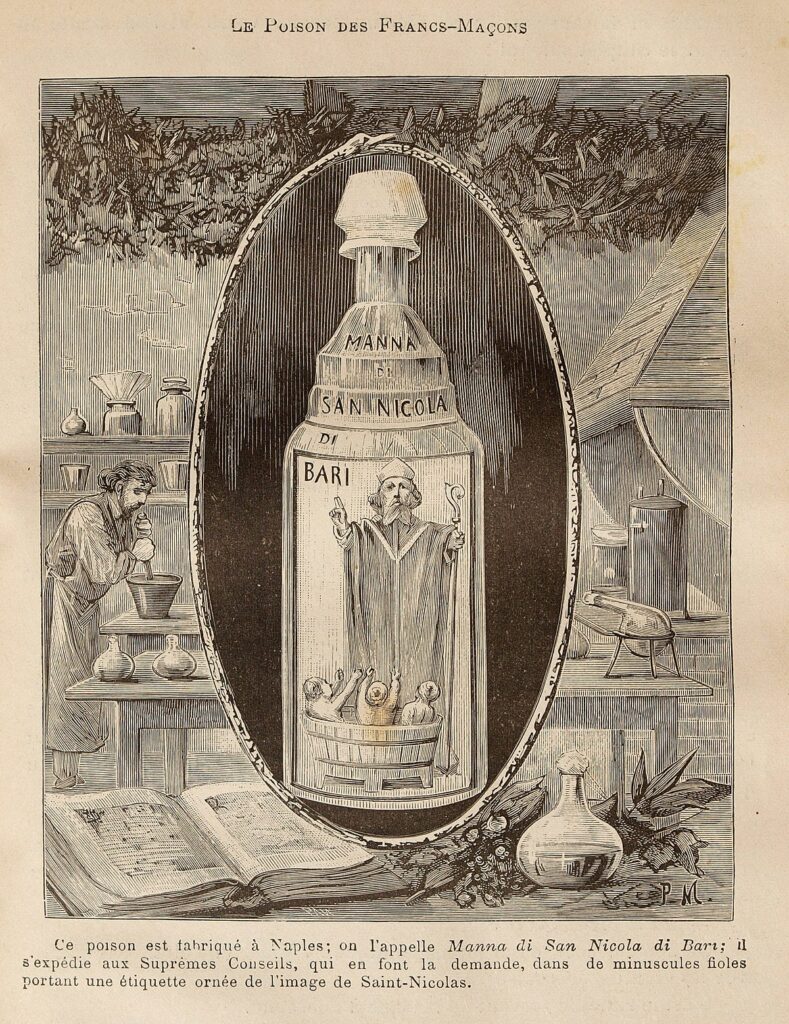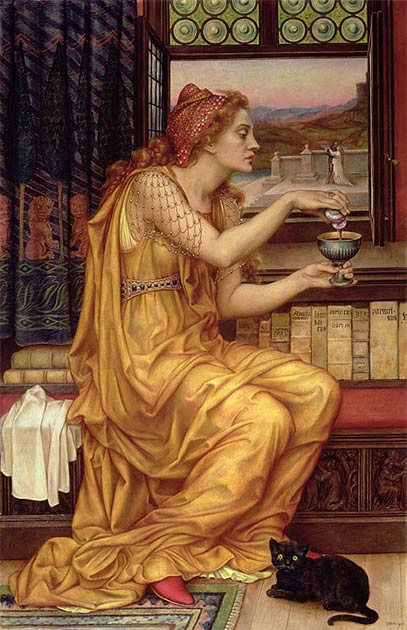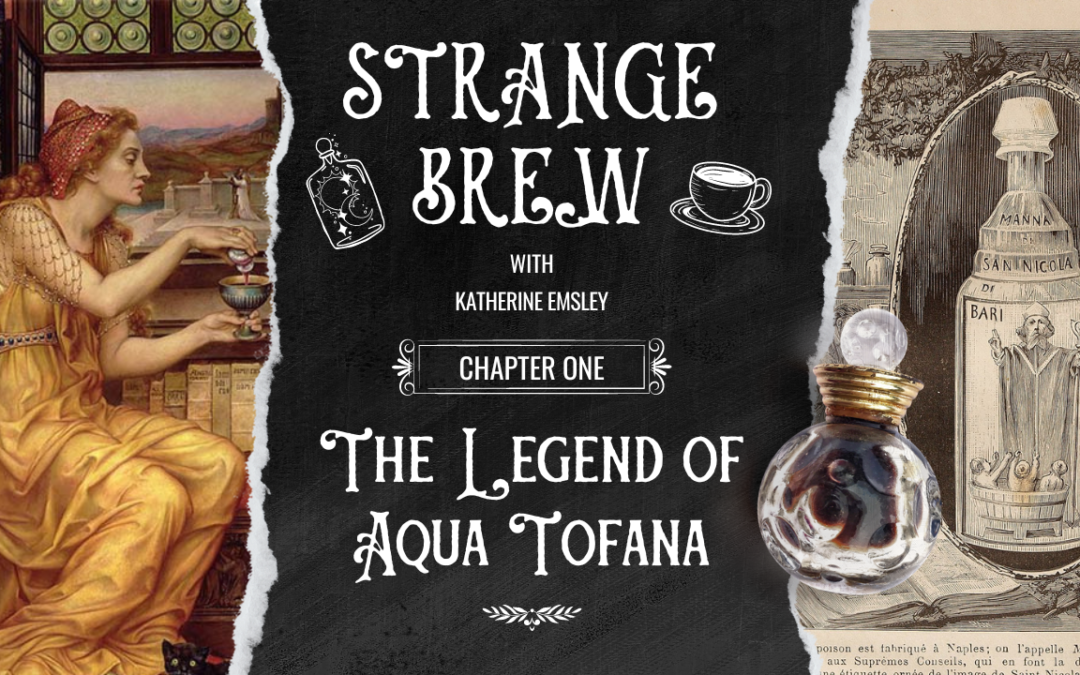
Aqua Tofana, a potent poison originating in 17th-century Sicily, gained infamy for its widespread use in cities throughout Italy. Associated with Giulia Tofana, the alleged leader of a sinister group of poisoners in Rome, Aqua Tofana was sold to desperate women seeking a way out of abusive or undesirable marriages. During this time, marriages were often arranged and these women had very little choice in the matter.
The earliest documented mention of Aqua Tofana dates back to 1632-33 when it was used by two women, Francesca la Sarda and Teofania di Adamo, to carry out their lethal deeds. It is believed that Teofania may have been the inventor of the poison. Teofania paid the ultimate price for her crimes, but other women connected to her, including her daughter, Giulia Tofana, and Gironima Spana, continued the production and distribution of the poison in Rome.
Dubbed “Manna di San Nicola” (“Manna of St. Nicholas of Bari”), Aqua Tofana may have adopted this name as a marketing ploy to deceive authorities. It was openly sold, disguised as both a cosmetic and a devotional item, packaged in vials adorned with images of St. Nicholas. Shockingly, it is alleged that over 600 victims, predominantly unwanted husbands, succumbed to this poison.
While the exact blending method remains elusive, the primary components of Aqua Tofana are known to be arsenic, lead, and possibly belladonna. This colourless and tasteless liquid lent itself to inconspicuous administration, easily mixed with water or wine during meals.
What made Aqua Tofana particularly insidious was its slow-acting nature, mimicking symptoms of a progressive illness or natural causes. Victims experienced a sequence of symptoms akin to those of arsenic poisoning. Initially, a small dosage would induce cold-like symptoms. By the third dose, the victim would be severely ill, suffering from vomiting, dehydration, diarrhoea, and a burning sensation in the digestive system. Finally, the fourth dose proved fatal. This delayed effect allowed victims time to prepare for their imminent demise, including writing wills and seeking repentance.

It is important to debunk the unfounded rumour surrounding Aqua Tofana’s involvement in the death of Wolfgang Amadeus Mozart. While Mozart himself perpetuated this claim, there is no credible evidence supporting it.
Giulia Tofana

Regrettably, there is limited knowledge about Giulia Tofana, and it is essential to remember that our understanding of her is primarily based on speculation and passed-down stories. Various accounts of her and her poison exist, making it difficult to distinguish truth from fiction.
Giulia Tofana lived in 17th-century Italy and gained notoriety as a skilled poisoner. Opinions about her character differ, with some regarding her as a murderous villain while others consider her a hero.
According to popular narratives, Giulia Tofana was born in Palermo, Sicily around 1620. Supposedly, she learned the art of poison-making from her mother. Historians speculate that she might have adopted her mother’s first name as her last name, as was common at the time. This led to the speculation that she was the daughter of another Palermo poisoner known as Thofania d’Adamo.
Thofania (Giulia’s mother) was executed on July 12, 1633, in Palermo for poisoning her late spouse, Francesco d’Adamo, and engaging in the illegal trade of lethal poison. The year before Thofania’s execution, her accomplice, Francesca La Sarda, was also executed for poisoning.
Giulia allegedly produced and sold the poison called Aqua Tofana, primarily targeting women seeking to escape abusive marriages or eliminate inconvenient husbands. It is important to note that historical records are speculative, and the information we have about her is based on rumours and legends.
One version of the story suggests that Giulia Tofana fled to Rome following her mother’s execution and established a business selling Aqua Tofana. In Rome, she formed a network of poisoners that began distributing the poison. It is said that in the 1650s, six women were involved in this network, including Girolama Spare, who supposedly took over the operation after Giulia’s death.
Legend has it that the poison was responsible for the deaths of hundreds, if not thousands, of people. Eventually, Giulia’s activities drew the attention of the authorities.
According to one account, in 1659, Giulia and her daughter, Girolama Spera, were arrested and brought to trial. Giulia reportedly confessed to her crimes and implicated her daughter as well. According to this version, they were both executed by beheading in July 1659. However, the documentation of their trials and executions is scarce, adding to the mystery surrounding the story.
Some historians claim that Giulia died peacefully in her sleep in 1651, with no one aware of her involvement in poisoning activities.
Other versions of the story suggest that the legend of Tofana was fabricated as a cautionary tale to dissuade women from seeking independence through murder. Therefore, distinguishing fact from fiction becomes a significant challenge.
